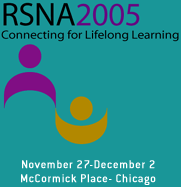
Abstract Archives of the RSNA, 2005
Ling Tan MD, Presenter: Nothing to Disclose
Weimin Chai, Abstract Co-Author: Nothing to Disclose
Kemin Chen MD, PhD, Abstract Co-Author: Nothing to Disclose
Hua Wei Ling MD, Abstract Co-Author: Nothing to Disclose
Jianjun Liu, Abstract Co-Author: Nothing to Disclose
To evaluate the clinical value of MRTA in patients with primary trigeminal neuralgia and discuss the etiology of the primary trigeminal neuralgia with MRTA.
One hundred and forty-seven patients with unilateral trigeminal neuralgia and a control group of 44 healthy people underwent MR examination of trigeminal nerve. 3D-TOF sequence was used for the MRTA scan. Two experienced radiologists who were blinded to the clinical findings analysed the root entry zone of both side trigeminal nerves in all images. The judgment was made on if there were some vessels close to the trigeminal nerve and on the relationship between the vessel and the nerve. The diameter of the offending vessel, the distance from the offending vessel’s contact point to the pons and the direction of the vessel toward the nerve were also recorded. The relationship between the offending vessel and the trigeminal nerve was categorized as no offending vessel, contact, and compresion. The direction of the offending vessel was recorded according to the angle between the vessel and the nerve.
Two hundred and forty two trigeminal nerves of all 382 nerves can be detected offending vessels on MRTA images. No difference(p>0.05)of the diameter of the offending vessel existed between asymptomatic group(1.13±0.27mm) and symptomatic group(1.24±0.65 mm). However, the distance from the offending vessel’s contact point to the pons in symptomatic group(2.35±1.94mm) was shorter than that in the asymptomatic group(3.86±2.26mm) (p<0.01). The direction of the vessel toward the nerve in the symptomatic group had significant difference from that in the asymptomatic group(p<0.01). The rate of the vessel-nerve contact in the symptomatic group was much higher than that in the asymptomatic group(p<0.01). It implies that vessel compression is an important cause of primary trigeminal neuralgia. Significant differences was observed between asymptomatic and symptomatic groups.
MRTA is the most important examination for the patients with primary trigeminal neuralgia before the surgery. MRTA is reliable to estimate the relationship between the offending vessel and the nerve.
Tan, L,
Chai, W,
Chen, K,
Ling, H,
Liu, J,
MRTA Imaging Analysis of Primary Trigeminal Neuralgia. Radiological Society of North America 2005 Scientific Assembly and Annual Meeting, November 27 - December 2, 2005 ,Chicago IL.
http://archive.rsna.org/2005/4411541.html

